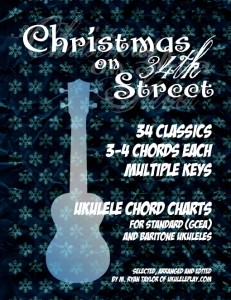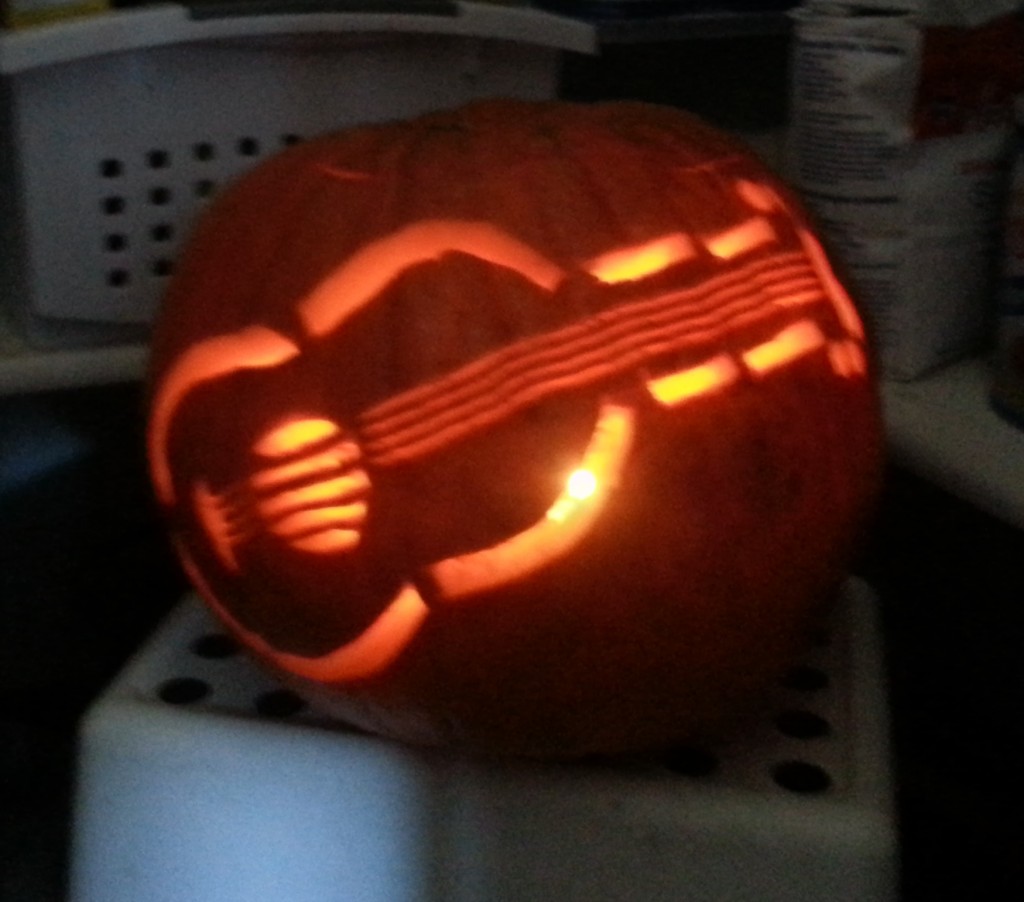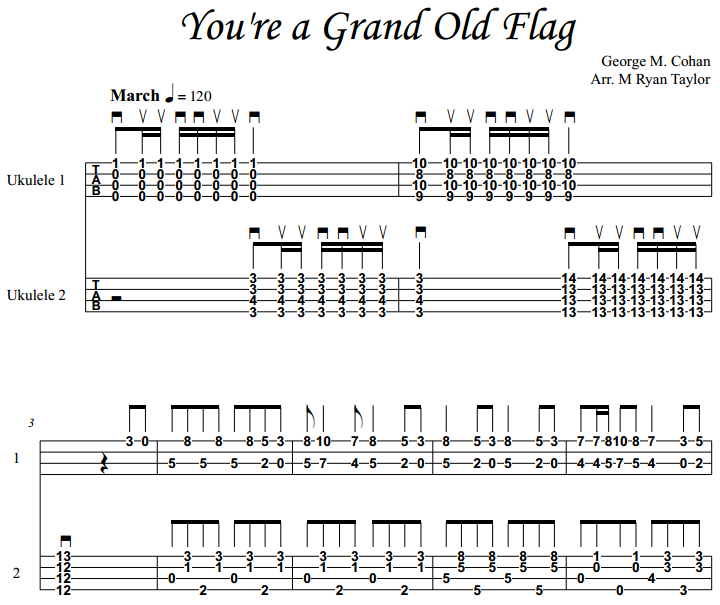HI*Sessions : Learning from the Best
I often suggest to my students that they watch the great uke players as well as listen to them. You can learn a lot just by watching. One of the great places to do this is HI*Sessions, a youtube channel that occasionally features some of the greatest ukulele players of our day, all in up-close-and-personal hi-def. Here are the episodes featuring some of my favorite players (you can skip the intros with the little navigation arrows at the bottom of the player) . . .
Kalei Gamiao
James Hill
Aldrine
Herb Ohta Jr.
Brittni
Taimane
Review: Ukulele Duets
 Ukulele Duets, released by Mel Bay.
Ukulele Duets, released by Mel Bay.
As a blogger and an ukulele book author, I generally try to be as kind and positive as I can about any ukulele book I come across. I try to imagine who would enjoy the book, rather than whether I would find it personally useful.
I had great hopes for this book. I teach ukulele groups and a book of duets would be a wonderful resource. The formatting is nice and clean; it includes melody and tab lines for each of the ukuleles.
Problems started to arise though, when I played through the book. One ukulele plays through the melody, which is no surprise. Where I was dissapointed, and frankly think makes this book useless, is that the harmony part on the second uke is almost entirely, in every arrangement, a parallel third or fourth above the melody. Anyone could figure out how to play in parallels. Who needs a whole book for it?
In short, there is no real arranging here, just a formula used over and over again. The ears get tired of this kind of thing really quick. For this book to be useful, I would expect to some good/interesting counterpoint.
Thankfully, Amazon refunded my purchase.
Review: Cowboy Songs for Ukulele
 Cowboy Songs for Ukulele from Hal Leonard includes a nice selection of tunes from the classic days of cowboy songs, before cowboy turned into country; think Gene Autrey, Johnny Cash, Roy Rogers and various cowboy folk songs. Some songs I might work up myself include Back in the Saddle, Ghost Riders in the Sky, Happy Trails, and various of the Gene Autrey songs that are included.
Cowboy Songs for Ukulele from Hal Leonard includes a nice selection of tunes from the classic days of cowboy songs, before cowboy turned into country; think Gene Autrey, Johnny Cash, Roy Rogers and various cowboy folk songs. Some songs I might work up myself include Back in the Saddle, Ghost Riders in the Sky, Happy Trails, and various of the Gene Autrey songs that are included.
Who this book is for:
- Folks that love cowboy tropes and songs; these are full of wonderful cliches about trails, cowgirls, gunfights and more.
- Folks that prefer a chords-over-melody-line-and-lyrics format (like The Daily Ukulele). I enjoy having a melody line to help learn unfamiliar songs without having to look up a recording.
- Folks that are comfortable improvising/making up their own strum/fingerpicking patterns on the fly.
Also worthy of note, the chord level in this book is fairly easy, making it a great selection for groups with mixed levels of players or advancing beginners.
Review: Two-Chord Songs (Guitar Chord Songbook)
 Two-Chord Songs (Guitar Chord Songbook) by Hal Leonard has an eclectic mix of rock, pop and country songs that I’m excited to explore more. Some songs I am familiar with (Paperback Writer, ABC, Day-O, etc.), and others I’m going to have to get on youtube or spotify and look up, but with these easy resources for learning the melodies of songs freely available, I’m just not too worried that there are songs I don’t know in the collection.
Two-Chord Songs (Guitar Chord Songbook) by Hal Leonard has an eclectic mix of rock, pop and country songs that I’m excited to explore more. Some songs I am familiar with (Paperback Writer, ABC, Day-O, etc.), and others I’m going to have to get on youtube or spotify and look up, but with these easy resources for learning the melodies of songs freely available, I’m just not too worried that there are songs I don’t know in the collection.
Although I was a little puzzled when Hal Leornard sent me a guitar book for review, it doesn’t take much imagination or skill to turn ANY songbook with chords into an ukulele songbook; all you need is a ukulele chord reference (chart, dictionary or online app) and the patience to look up the chords and write them into the music. Actually, you don’t even need much patience when it comes to songs that only have two chords!
As a teacher, I love two chord songs (yep, I’ve even published two songbooks dedicated to them). When practicing transitions between chords, I find it best to focus on two chords at a time and two chord songs offer almost instant gratification to the student as a reward for their dilligence.
So, if you’re a beginner, or just like it easy, consider ignoring the guitar on the cover of this book and picking up a copy to add to your ukulele songbook collection. You might also consider picking up the Hal Leonard Ukulele Chord Finder: Easy-to-Use Guide to Over 1,000 Ukulele Chords for less than six bucks to make writing in your ukulele chord symbols a snap (I use this book all the time).
Review: The Best Songs Ever (Ukulele Chord Songbook)
 The Best Songs Ever (Ukulele Chord Songbook) from Hal Leonard is an interesting selection of songs in the chords-over-lyrics format many ukers are accustomed to.
The Best Songs Ever (Ukulele Chord Songbook) from Hal Leonard is an interesting selection of songs in the chords-over-lyrics format many ukers are accustomed to.
Who this book is for:
- Players of a certain age to whom these songs are familiar. I’m in my early forties and hadn’t heard of many of the songs in this book (maybe half). However, my mother flipped through this book and knew almost every song (she’s in her early seventies).
- Players who want the songs in the original keys and are not afraid of learning large sets of (sometimes difficult) chords. Many songs feature over 20 chords.
- Players who prefer the chords-over-lyrics format and don’t want to be bothered with treble cleff, notes, or tabs.
If you fit the above profile, this book may be a good addition to your library.
I was sent a review copy of this book from Hal Leonard.
Review: Ukulele Aerobics by Chad Johnson
This is a review of Ukulele Aerobics: For All Levels, from Beginner to Advanced by Chad Johnson that I posted on Amazon . . .
Who this book is NOT for: Beginners. The only reason this book got a one-star rating from someone is that it is marketed as an ‘ALL LEVELS’ book, which I consider false advertising (which is why I see it as a four star book). I can say this with some confidence because I’ve taught hundreds of beginning students to play the ukulele and this book would leave most of them in the dust, discouraged and disheartened. Also, this book is NOT for people who prefer to learn the ukulele organically . . . by which I mean ‘one song at a time’ (the book includes drills for skills in seven categories, there are no songs in this book). Despite these drawbacks . . . this is an awesome book.
Who this book IS for: players with a firm grasp of the basics, that have a good number of chords already under their belt, have good practicing skills, aren’t afraid of standard staff notation and are glad to see it side by side with tablature. If this is you, you’re going to get a lot out of this book.
That said, I consider myself an intermediate player with a lot of musical knowledge that translates over from other instruments I’ve learned to play. Even with that kind of background, there’s some pretty tough stuff in this book that you’re going to have to be patient with . . .
The toughest part may be the advanced/tricky chord shapes that are thrown out pretty early in the book (I have a hard time understanding the rhyme/reason for the order in which chords are introduced). But, if you’re like me, you’ll enjoy stretching yourself a bit to make your fingers fit these shapes.
I like what one of the other reviewers said about using each week as a daily round of seven drills. I think people will get a lot more out of the book practicing this way as some of the drills are not going to be mastered in a day.
WHAT I LOVE: There’s stuff in this book I haven’t seen anywhere else, and I’ve bought about twenty instructional ukulele books in my quest to be a better teacher. Also, as a singer/songwriter, it is so nice to be able to pick up new techniques, fingerpicking, strumming, chords, riffs to inspire my own writing.
Ukulele Aerobics can be found on Amazon (link above) or on Hal Leonard’s website: http://www.halleonard.com/product/viewproduct.do?itemid=102162
How should I practice? : 3 Top Tips for Making Fast Progress
 I’ve thought a lot about this quote, attributed to the great pianist Bill Evans, “It’s better to practice one song for 24 hours than play 24 tunes in one hour.”
I’ve thought a lot about this quote, attributed to the great pianist Bill Evans, “It’s better to practice one song for 24 hours than play 24 tunes in one hour.”
By nature, I’m a 24-tune-an-hour kind of guy. I love variety. I love playing through songs. That said, I know there is a better way to practice and make progress. Here are my three top tips for making quick progress on your instrument.
1. Slow is Fast
Everyone wants to play a song up to tempo, even at the beginning. The problem is, we experience time in a very relative way. When things are easy, our timing is pretty spot on, but when things get tough, time seems to warp and we slow down. Sometimes, we don’t even realize we’re slowing down. If you want to test this, try playing a song that has some easy spots and some tough spots and then turn on a metronome and see what happens.
Because of this ‘time warp’ effect in our brains, people often lumber on through the difficult stretches without stopping, usually not realizing that they’ve slowed way down, only to speed up again when the going gets easy. This really messes with our sense of timing, which in itself is an important musical skill that must be developed.
The solution to this problem is to slow down and . . .
2. Put the Tough Spots on Loop
Forget about starting at the beginning every time. You know where the tough spots are in that song you’re practicing. Isolate a difficult passage of the music and put it on loop. Repeat that section slowly, over and over. It may only be a little twiddly-bit or lick, or it may be a full measure or two, or it may be a longer phrase. Isolate it and loop it . . . over and over and over again.
3. Practice with Someone (or Something)
Make sure you’re being honest with yourself. Practice with a metronome and keep looping those tough passages in a slow time. Then, as you feel more comforatable, raise the tempo, little by little until you’ve mastered the passage. Then, merge the passage back into the song. When you’ve got it to your satisfaction and feel you can’t make a mistake (or can’t take it anymore – in which case you can come back to it later), move on to the next difficult section and repeat the process.
One of the reasons I enjoy leading and practicing with my ukulele group, UFO HUM, is that it forces me to do this process with real people which are a lot more fun than metronomes. Alternatively, you can always use drum loops or recording of songs to practice with. The problem in these is controlling the tempo and slowing them down (though there is software for this, its too much trouble for me).
Conclusion
That’s the process I’ve found most helpful making real progress with my instrument: slow down, loop tough passages and use a metronome (or group) to make sure you’re being honest in your timing.
What practicing tips have you found useful? Please comment!
_______
Want more tips? Visit NPR’s 10 Easy Ways to Optimize Your Music Practice.
Review: The Ukulele Toolbox DVD 1
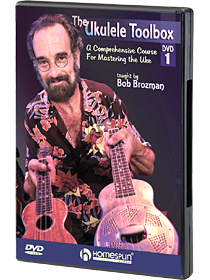 Here is my review and notes from The Ukulele Toolbox DVD 1 released by Homespun Video.
Here is my review and notes from The Ukulele Toolbox DVD 1 released by Homespun Video.
General observations: Over 2hrs of instruction from the late Bob Brozman. The video has a stream of consciousness, conversational tone. The presentation jumps quickly from concept to concept. Be prepared to pause and run back. If I was just starting out, and new little about music, this video would probably overwhelm me. As an intermediate player, I found much that was interesting for me to work on. One of the nice bonuses you should be aware of is that the DVD has a PDF with all the exercises and concepts Bob introduces for you to print off.
Notes
Tuning the Ukulele (GCEA) and issues
- Guitar tuning issues are magnified because of the smaller scale of the uke.
- Use an electronic tuner, but double check the instrument against itself.
- Practical information on adjusting the nut.
- Fine tune “1 to 1 ratio” peg head tuners with a “Pinto Bean Fine Tuner.”
Right Hand Rhythm
- Brain runs many different ‘software programs’ at the same time, so divide and conquer.
- Whole arm stroke . . . down with thumb and up with first finger.
- Swung rhythm vs Straight rhythm.
- Cutting off notes (muting): professional controls where the notes end. Mute with the fleshy side of the palm.
- Strums with thumb and index, index alone and middle finger alone.
- Triplet: down middle, up index, up middle.
- Practice slow and deliberately at first, but as you speed up be lighter with less effort.
- Use the fingerboard as a landing pad for strumming.
- Trying triplets on various beats of the measure.
- All about cutting, pasting and reassembling these little ideas.
- Four finger roll and four finger roll followed by the thumb (calls it a scroll).
- Arranging the landscape of your songs: aggressive, soft, etc.
- Triplet 2 (whole arm triplet): DOWN up down UP down up DOWN up down UP down up.
- 4 2 3 1 (string numbers) fingerpicking with the thumb and index.
- Fingerpicking partial chords with triplet accents.
- Left hand finger placement for partial chords (6ths).
- Blues turnaround.
- Importance of getting variety, cutting and pasting.
- Pinching strings 4 & 2 and 3 & 1.
- Strumming across different parts of the strings changes tone and accent.
- Use the first part of your practice to focus on right hand rhythm and challenge yourself to come up with interesting variations.
The Key of C
- String science, the Greeks, harmonics and home base.
- Scales all made up of combinations of whole steps and half steps.
- The C scale.
- C and G7 chords.
- Think ahead on chord changes.
- Incorporating melodies into chord positions.
- Cadential G7 (0535).
- Alternate F (2013).
- Fingerpicking 4 2 1 3 2 1 3 2
- Fingerpicking 4 2 1 3 2 1
- Many songs use just C, G7 and F.
- Chapter 15: Putting together a blues progression. C, C7, F (and F7), and G7 plus closing turnaround.
- Embellished turnarounds and alternate chord voicings.
- Playing C, G7 and F with the 2-4th fingers to prepare for barre chords.
- Getting more leverage for barre chords.
- Relationships of chords (1, 4, 5) vs. Names of chords (C, F, G7).
- Partial chords can suggest the chord you intend.
- Some chord theory on 9ths, etc.
- Basic ‘Slants’ (partial chords) on middle strings: 00 21 43 55 77 98, etc.
The Key of G
- 1, 4 & 5 = G, C & D7.
- Alternate C voicing.
- Short and long slants in the key of G on strings 1 & 2.
- Key of F = F, Bb & C7.
- Cycle of Fifths (Circle of Fifths) and dominant chords as questions: D7, G7, C7, F.
- Practicing more difficult chord shapes.
- Chord progression Bb, Bbm, F, D7, G7, C7, F. Ending Bb, Bbm, F.
Adding Minors
- Taking that chord progression back to C: F, Fm, C, A7, D7, G7, C.
- Major keys and their relative minors.
- A minor: Am, Dm, E7.
- Adding slaps to your strum patterns.
- 4 inversions for most chords.
- D minor: Dm, Gm, A7 (A dim).
- Chapter 31: 16 bar Calypso in Am: Am, Am, E7, Am, repeat, A7, Dm, G7, C, A7, Dm, E7, Am.
- Relative major Calypso progression.
- Sliding fully closed chords from underneath by one fret for swingtime numbers.
- 32 Bar Form: AABA. Examples with two kinds of bridges.
I Love a Ukulele
- Song tutorial.
Winning Video for UU Christmas on 34th Street Video Contest
I held a much under-promoted (I got really sick just after starting the contest) Christmas Video Contest on Ukulele Underground (link takes you to the thread on their forum where you can see all the entries). Despite the fact I didn’t get the word out like I’d like to have, there were still some great entries from the UU community and here is the winner:
Congratulations to Mina (who wins an Outdoor Ukulele) and thank you to everyone! Merry Christmas!
New ‘Ukulele Practice’ Pinterest Board
I’ve created a new pinterest board to collect practical ukulele tips, techniques, tabs and songs, http://www.pinterest.com/mryantaylor/ukulele-practice/, as a sister board to the general interest board, http://www.pinterest.com/mryantaylor/-ukulele-play-/ that has photos, performances and ukulele humor.
I found I had to do quite a bit of scrolling to find the any of the tutorials I’d pinned amidst all the levity, hence the split. Hope you enjoy both boards.
Glonk vs. Monk (Folk vs. Classical)
 I really have enjoyed reading Ralph Shaw’s blog, The Ukulele Entertainer. He has lots of great insights. This last week he posted a story from ukulele education pioneer Chalmers Doane (whose work I am familiar with and greatly respect). The story really bothered me for some reason. You can read the whole article here, but in essence . . .
I really have enjoyed reading Ralph Shaw’s blog, The Ukulele Entertainer. He has lots of great insights. This last week he posted a story from ukulele education pioneer Chalmers Doane (whose work I am familiar with and greatly respect). The story really bothered me for some reason. You can read the whole article here, but in essence . . .
Caveman Glonk has trouble communicating to the other members of the tribe his special log drumming skills, so he creates a kind of musical notation to communicate the info to his unmusical friends.
Whoa! Hold the presses! Music notation came about to teach music to the unmusical? Not so. Here is my reply:
“I’ve been a long time subscriber and know and admire the work of Chalmers Doane, but somehow this post really bothered me. Now that I’ve had a chance to mull over this over and calm down a bit, I still have some problems with the analogy.
First of all, this is not how our system of musical notation was invented or developed. We actually know quite a bit about the development of early Western notation. The oldest surviving example of a complete composition comes from the Greeks; the Greeks were hardly Glonk, they were an advanced society. The composition is an epitaph, and I think that is symbolically fitting as a kind of ‘forget me not.’ See http://en.wikipedia.org/wiki/Seikilos_epitaph
I’ve heard a recording of a recreation of the Seikilos epitaph and it is a lovely little melody. I’m so glad and grateful someone had the foresight to write it down and preserve it for us. It has touched my heart and at one time I even wrote a set of variations on it for a mini Greek mythological drama.
There is no evidence to support the idea that music notation developed to aid the unmusical (which I personally find a repugnant thought – every human being has the potential to be musical if music is treated as an integral part of their development). There is a lot of evidence to suggest that notation was developed to aid our memory and transmit information over time and space. We are awfully forgetful creatures and the act of writing, both linguistic and musical, screams out, “I don’t want to forget this!”
In an age of easy recording, it is easy to lose sight of how important musical notation has been to the development of our musical culture. Each generation has had to opportunity to build on the wealth of musical experimentation of the past, because it has been written down.
It is also important to remember that modern Western notation began with monks, not the folk musicians and troubadours (though they quickly caught on to its power and adapted it for their own purposes). Monks were entrusted with our collective memory in those days and writing was the way to ensure things were not forgotten. On top of that, there was the task of keeping track of a complicated liturgical calendar and the many thousands chants that were created to serve it. That was the origin of our musical notation system.
I highly value the ‘folk’ tradition, the transmission of ideas, music, and stories through word of mouth. That doesn’t mean I have to devalue the ‘classical’ tradition and the benefits and insights it has brought into my life. I’ve lived in both worlds, and I’m frustrated that we seem to have to have this kind of musical snobbery on both sides of the fence. “You guys aren’t real muscians.” “No, its you guys that aren’t real musicians.” Blegh!
Also, the idea that somehow “the people who couldn’t play music got control of a system for teaching it,” is so insulting. This runs hand in hand with the idea that “those who can’t, teach.” Which is so patently ridiculous as to defy reason. You could fill vaults with stories of great musicians that were also great teachers (I recognize you didn’t mean to imply this, you after all are a teacher – I have all your DVDs).
One may as well say, “there are composers and then there are parrots.” If a musician isn’t writing and performing their own material, aren’t they just a parrot? I don’t believe that at all, but this is the kind of divisive logic that the fictional Glonk narrative is based on.
Also, most of the teachers I’ve had in my life (almost all classically trained) have always tried to get me beyond the notes on the page and to be expressive. None of them ever said, “Stop with what’s here on the page, don’t add any musicality to it.” I find it interesting that some (not all) of the best performers in the ukulele world have had some background with classical music: Sarah Maisel (former violinist), Craig Chee (former/current cellist), Daniel Ho (classical guitar) . . .
That said, I’ve loved your work and your blog and am a fan.”
New Book Reviewed on Got a Ukulele
Read Barry Maz’s review of my new ukulele songbook Christmas on 34th Street:
Barry is the author of a number of great ukulele books for beginners that are available on Amazon.
Christmas on 34th Street : 34 3-4 Chord Classics for Ukulele and Baritone Ukulele
- Christmas on 34th Street eBook on Sellfy
- Christmas on 34th Street Printed Edition on Amazon.
- Free sample below (see contents)
34 Christmas Classics arranged for Ukulele (GCEA) and Baritone Ukulele by M. Ryan Taylor of UkulelePlay.com, each with only 3-4 chords each and presented in multiple keys to allow you to choose which is best for your vocal range and playing ability (also allows for easy modulating between verses).
Selected and arranged with ukulele clubs, jamming groups and classrooms in mind, where players may range from beginners to advanced players. Most of the songs have been placed in keys that allow a standard ukulele strung with traditional / re-entrant / high-g GCEA tuning to pluck the melody, allowing groups to create simple duets between pickers and strummers on the fly.
Songs include:
Away in a Manger
Boars Head Carol
Bring a Torch, Jeannette Isabella
Christmas is Coming!
Coventry Carol
Deck the Hall
Ding Dong! Merrily on High!
First Noel, The
Friendly Beasts
Go Tell it On the Mountain
Good Christian Men Rejoice
Good King Wenceslaus
Here We Come A-Wassailing
Holly and the Ivy, The
In the Bleak the Midwinter
Infant Holy, Infant Lowly
Jingle Bells – free sample!
Jolly Old St. Nicholas
Joy to the World
March of the Three Kings, The
Masters in this Hall
O Come, Little Children
Once in Royal Davids City
Rocking Carol
Shepherd! Shake Off Your Drowsy Sleep
Silent Night
Sing We Now of Christmas
Sussex Carol
Twelve Days of Christmas, The
Up on the Housetop
Wassail, Wassail, All Over the Town!
We Wish You a Merry Christmas
Wexford Carol, The
What Child is This?
Want more simple, but awesome Christmas songs to add to your repertoire? Check out The Two Chord Christmas Songbook.
The Uke-olantern (Post-Halloween Ukulele Fun)
This jackolantern was carved by one of my students, The Vocal Sokol (links to her blog):
Farewell Halloween, until we meet again next year!
The Ghost of the Ukulele
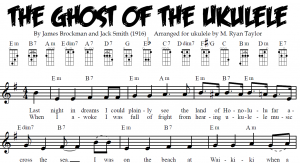 A silly little offering for Halloween, this song came out in 1916, riding on the ukulele’s first wave of popularity:
A silly little offering for Halloween, this song came out in 1916, riding on the ukulele’s first wave of popularity:
“Last night in dreams I could plainly see the land of Honolulu far across the sea, I was on the beach at Waikiki, when a million ukuleles started chasing me . . .”
Original recording: http://www.loc.gov/jukebox/recordings/detail/id/5447/
I’d hoped to do a video, but just didn’t have enough time. I hope you enjoy the music anyway! Send me videos if you make them! Happy Halloween!
More Halloween fun:
- Thirteen for Halloween : Ukulele Edition. 13 fun songs by M Ryan Taylor celebrating all things that go bump in the night. The original album and a video playlist on YouTube.
Truth Eternal
- Truth Eternal (PDF download) by Parley P. Pratt and Alexander Schreiner, arranged by M. Ryan Taylor.
This simple arrangement provides a fingerpicking and strum pattern that can be used on alternating verses or combined with two to three ukuleles (with the melody picked).
First Ukes
Four ukulele bloggers chime in on their first ukulele and tips for beginners looking for a first instrument. You can find the article at http://circuitsandstrings.wordpress.com/2013/10/13/my-first-ukulele-four-bloggers-share-their-experience/
Ukulele Tuning Tip for New Strings
Tuning an ukulele for the first time, you might wonder, “What is wrong with this instrument? It just won’t stay in tune.” Some conclude that, “The tuners must be slipping,” but if you have geared tuners, this is usually not the case. It is natural for new strings stretch out for the first few weeks of use until they ‘settle in’ and stay in tune for more than a few minutes.
However, if you’d like to break your new strings in a little faster, I suggest that the first time you tune them that you tune them to Canadian tuning: ADF#B (reference notes on ukehunt), a whole step higher than standard GCEA. What then? Walk away from your ukulele for a few hours (or a day) . . .
When you come back to your uke, it will be much easier to tune to GCEA and stay there for a longer period of time. Tuning the first time to Canadian tuning will not likely hurt your uke either, as thousands of Canadians tune it that way every day.
When you tune GCEA, the easiest way is with an electronic tuner, but here is a video reference to tune to if you need it:
Funiculi Funicula
http://youtu.be/i9CFFpA6CMQ
- Funiculi Funicula – Neapolitan (original) pdf with uke chords
- Funiculi Funicula (Italian) pdf with uke chords
One of the all-time most popular Neapolitan songs (an Italian dialect), performed by countless tenors across the globe, including the big three. A fabulous song, all about the funicular railway on mount Vesuvius and love, of course.
My contribution to a uke article
. . . on recording setups. Read it here: http://uke4u.com/the-ukulele-recording-setup-of-5-ukulele-bloggers/
The Spirit of God – New Ukulele Tablature
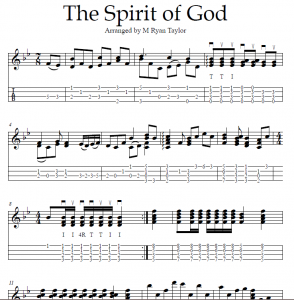 A new arrangement of one of my favorite hymns:
A new arrangement of one of my favorite hymns:
You can see and hear the original hymn at https://www.lds.org/music/library/hymns/the-spirit-of-god?lang=eng. The hymn has a long history, and was sung at the first LDS temple dedication in 1836. It is still sung today around the world in LDS congregations and at temple dedications.
Lyrics of the first verse and chorus:
The Spirit of God like a fire is burning!
The latter-day glory begins to come forth;
The visions and blessings of old are returning,
And angels are coming to visit the earth.
We’ll sing and we’ll shout with the armies of heaven,
Hosanna, hosanna to God and the Lamb!
Let glory to them in the highest be given,
Henceforth and forever, Amen and amen!
You can learn more at http://en.wikipedia.org/wiki/The_Spirit_of_God_Like_a_Fire_Is_Burning.
Beyond D DU UDU : Favorite ‘Go-To’ Strums from 5 Ukulele Bloggers
Everyone seems to know the unofficial international ukulele strum, D DU UDU, but there is so much more you can do with the right hand. 5 ukulele bloggers weigh-in on their favorite ‘go to’ strums . . .
Modified Clawhammer Strum
One of my favorite strums goes like this:
- Thumb plucks “c” string.
- Down strum all four strings.
- Index finger pluck “a” string.
- Thumb plucks “g” string.
- Down strum all four strings.
http://youtu.be/QFx8jdowMI8
A variation of this pattern (and a song tutorial) can be found here:
http://circuitsandstrings.wordpress.com/2013/01/18/lafayette-lilt-tutorial/
~Daniel Hulbert of circuitsandstrings.wordpress.com
Daniel will be teaching at this years Utah Uke Fest.
SKA Patterns
This video will (hopefully) supply you the foundation you need to start jamming with some ska tunes.
Before I had a family and a real job, I spent my days touring with a couple different ska bands. For some reason this genre of music, with it’s happy upbeats and carefree attitude has always appealed to me and the style transfers quite well to the ukulele. I guess that it makes sense…the ukulele originates from a sunny island (Hawaii) and ska music comes from a similar, albeit different island (Jamaica).
This style of music is all about timing – your strumming hand and fretting hand really have to be in sync and know what each other is doing. Like riding a bicycle, it might be frustrating and seem impossible at first, but with enough patience it will eventually click.
~Miles Ramsay of UKEonomics.com
The ‘Easy’ Split Stroke
This video demonstrates a simplified version of the split stroke with the song, The Old Ark’s a Moverin’ that I teach in my Level 2 ukulele classes:
This ‘easier’ version of Split Stroke splits 2 ‘triplet strums’ and a down-up evenly across 4 beats to create a syncopated, driving foundation for singing. Here’s two ways to look at it:
- Dt uD tu Du
- Dtu Dtu Du
D = accented down strum with the index finger
t = strumming down with the fleshy part of the thumb
u = up strum with the fleshy part of the index finger
If you’re just getting started with split/syncopated rhythms, take it slowly at first and work your speed up little by little.
~M. Ryan Taylor of UkulelePlay.com
Bossa Nova Strumming
Chords:
Tuning: G C E A ( high G ), Beat: 4/4, Tempo: 118 bpm
Strumming Pattern:
This is one way to play Bossa Nova style on your ukulele:
- First learn the strumming pattern ( 2 bars long ).
- In the beginning mute the strings with the left hand as shown in the the video.
- Mind the change from downbeat ( downstroke ) to offbeat ( upstroke ). This is called Partido Alto and brings some Latin touch in the strumming.
- Start with one chord and then add the others.
- Mute the strings between the strokes with your left hand.
~FriendlyFred of uke4u.com
Vaudeville and Variety-Style Strumming
I tend to play jazz and pop from the first four decades of the 20th Century, music that calls for strums that provide the ability to create syncopated rhythmic combinations, including triplets, 16th notes and 32nd notes.
The four strums I use most often are known as the “fan stroke”, the “triple”, the “double-time”, and the “split stroke” – as George Formby called it – or “syncopated stroke” – as Roy Smeck referred to it. All four are used liberally in this video of the 1931 tune “Lady of Spain”, which has forever been associated with the accordion.
I play the verse and refrain through twice using a combination of fingerpicking and various strokes and rolls, including flamenco-style finger rolls in refrain at 0:15, 1:15 and 1:24.
Then, at 1:32, I pick up the pace and run through the refrain using two strokes primarily: the triple and the double-time.
Let’s start with the simplest: the double-time. This is just a “down-up” every beat. It’s useful for creating a double-time feel if you increase speed and play it “down-up – down-up” every beat.
Now, the triple. This is often mistakenly referred to as a “triplet” stroke. It is and it isn’t. The triple stroke is actually a quarter-note triplet followed by an additional quarter note downstroke – “da-da-da – daa”. This is achieved by doing a downstroke across all four strings with the index, followed by a downstroke with the thumb, followed by an upstroke with the index and thumb together, followed by a downstroke with the index and thumb together – “down-down-up – down”.
I use the fan stroke several times in this arrangement. At 1:56 and again at 3:11, I play the classic triplet fan stroke. Its made up of three strokes – a downstroke with the nails of the pinky and ring finger, followed by a downstroke with the pad of the thumb, followed by an upstroke with the nail of the thumb. The effect is a straightforward “da-da-da”. You can see that I break my wrist when I do it, moving my hand in a circular fashion. On the downstroke with the pinky and ring fingers, the hand fans out – hence the name of the stroke. This stroke can be immediately and infinitely repeated, with the effect of an almost infinite triplet.
Finally – there’s the split stroke – I play a version of the refrain based on the split stroke starting at 2:28. It was the hardest of the above strokes to learn and – unfortunately – it’s the hardest for me to explain. The basic stroke is accomplished with the thumb and forefinger held together as for a basic downstroke strum. The stroke is “down-up-Down, down-up–Down, down-up” and the rhythm is two eighth notes followed by two syncopated triplets. The name “split” comes from the fact that on the initial downstoke, you only hit the botton two strings of the uke; then on the upstroke, you only this the op two strings of the uke. Then, on the third downstroke, you strike all four strings. This approach gives you the right accents. You hit the accents on the full four-string downstrokes of the figure, so the effect is “ba-da-DA, ba-da-DA, ba-da”. I learned how to play this stroke from watching videos made by fellow George Formby Society members Matt Richards http://www.youtube.com/watch?v=qhjy9_3rusc Peter C. Nixon and Mike Warren http://www.youtube.com/watch?v=t8cnPP3SU5s . I also highly recommend their tutorials of the additional Formby strokes – the Fan, the Triple, and the Shake, which I am still struggling with.
Those four strokes are “go-to” for me, with the Triple and Double being most commonly used to drive the tempo, but the fan and split stroke are often used in the way that a tenor banjo player might use a tremolo – as a means of holding a note or injecting interest in a solo or accompaniment.
~ John Bianchi of theukaholic.blogspot.com
Thanks to all the guest bloggers for sharing some awesome info!!!
You’re a Grand Old Flag : Ukulele Duet
A classic piece of George M. Cohan Americana arranged for two or more ukuleles:
Enjoy!
Didn’t My Lord Deliver Daniel
One of my favorite spirituals in a variety of different versions:
- Didn’t My Lord Deliver Daniel (pdf)
- Didn’t My Lord Deliver Daniel 2-part (pdf)
- Didn’t My Lord Deliver Daniel 2-part with Descant (pdf)
- Didn’t My Lord Deliver Daniel Choir Only (pdf)
“He delivered Daniel from the lion’s den . . . then why not every man?”
Enjoy!
There is a Haunted House in Town
This parody of “There is a Tavern in the Town” is another of my Halloween favorites:
Enjoy!


